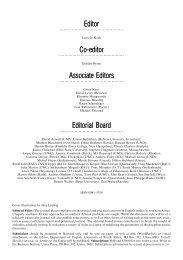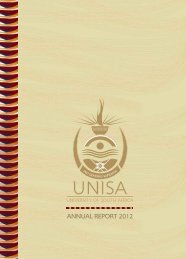Download the Annual report 2011 - Unisa
Download the Annual report 2011 - Unisa
Download the Annual report 2011 - Unisa
Create successful ePaper yourself
Turn your PDF publications into a flip-book with our unique Google optimized e-Paper software.
2.10.2 Operating leases<br />
UNISA ANNUAL REPORT <strong>2011</strong><br />
Operating lease payments are recognised in profit or loss on a straight-line basis over <strong>the</strong> lease term. In negotiating<br />
a new or renewed operating lease, <strong>the</strong> lessor may provide incentives for <strong>the</strong> University to enter into<br />
<strong>the</strong> agreement, such as up-front cash payments or an initial rent-free period. These benefits are recognised as<br />
a reduction in <strong>the</strong> rental expense over <strong>the</strong> lease term on a straight-line basis.<br />
2.11 PROVISIONS<br />
Provisions are recognised when <strong>the</strong> University has a present legal or constructive obligation as a result of past<br />
events, it is probable that an outflow of resources embodying economic benefits will be required to settle <strong>the</strong><br />
obligation, and a reliable estimate of <strong>the</strong> amount of <strong>the</strong> obligation can be made. Provisions are determined by<br />
discounting <strong>the</strong> expected future cash flows rate that reflects current market assessments of <strong>the</strong> time value of<br />
money and, where appropriate, <strong>the</strong> risks specific to <strong>the</strong> liability.<br />
2.12 FINANCIAL INSTRUMENTS<br />
Non-derivative financial instruments comprise investments in equity and debt securities, student and o<strong>the</strong>r<br />
receivables, cash and cash equivalents, loans and borrowings, and trade and o<strong>the</strong>r payables.<br />
2.12.1 Measurement<br />
Non-derivative financial instruments are recognised initially at fair value plus, for instruments not at fair value<br />
through profit or loss, directly attributable transaction costs, for financial instruments through profit and loss,<br />
attributable costs. Subsequent to initial recognition non-derivative financial instruments are measured as described<br />
below.<br />
2.12.2 Interest-bearing borrowings<br />
Subsequent to initial recognition, interest-bearing borrowings are stated at amortised cost using <strong>the</strong> effective<br />
interest method, less any impairment losses.<br />
2.12.3 Student and o<strong>the</strong>r receivables<br />
Student and o<strong>the</strong>r receivables are subsequently classified as loans and receivables and measured at amortised<br />
cost using <strong>the</strong> effective interest method less any impairment losses.<br />
2.12.4 Cash and cash equivalents<br />
Cash and cash equivalents are measured at amortised cost, using <strong>the</strong> effective interest method. For <strong>the</strong> purpose<br />
of <strong>the</strong> cash flow statement, cash and cash equivalents comprise cash on hand, deposits held on call with<br />
banks, and investments in money market instruments, net of bank overdrafts, all of which are available for use<br />
by <strong>the</strong> University unless o<strong>the</strong>rwise stated. Bank overdrafts that are repayable on demand and form an integral<br />
part of <strong>the</strong> University’s cash management are included as a component of cash and cash equivalents for <strong>the</strong><br />
purpose of <strong>the</strong> statement of cash flows.<br />
2.12.5 Trade and o<strong>the</strong>r payables<br />
Trade and o<strong>the</strong>r payables are liabilities to pay for goods or services that have been received or supplied and<br />
have been invoiced or formally agreed with <strong>the</strong> supplier. Trade payables are subsequently carried at amortised<br />
cost using <strong>the</strong> effective interest method, less any impairment losses.<br />
2.12.6 Loans and receivables<br />
Loans and receivables are stated at amortised cost, less any impairment losses. Amortised cost represents <strong>the</strong><br />
original invoice amount less principal repayments received, <strong>the</strong> impact of discounting to net present value and<br />
impairment adjustments, where applicable.<br />
| 85 |

















